Documents: Go to download!
User Manual
- Owner's manual - (English)
- Quick Reference Sheet - (English)
- Energy Guide - (English)
- Garant�a - (English)
- Dimension Guide - (English)
User manual of Maytag WDT750SAKV (84 pages)
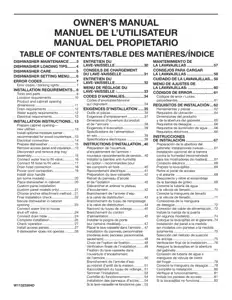
- INSTALLATION INSTRUCTIONS
- DISHWASHER MAINTENANCE AND CARE
Table of contents
OWNER'S MANUAL PLASTIC TUB DISHWASHER
INSTALLATION INSTRUCTIONS
REQUIREMENTS
Tools and Parts
Gather the recommended tools and parts before starting installation. Read and follow the instructions provided with any tools listed here.
Tools Needed:
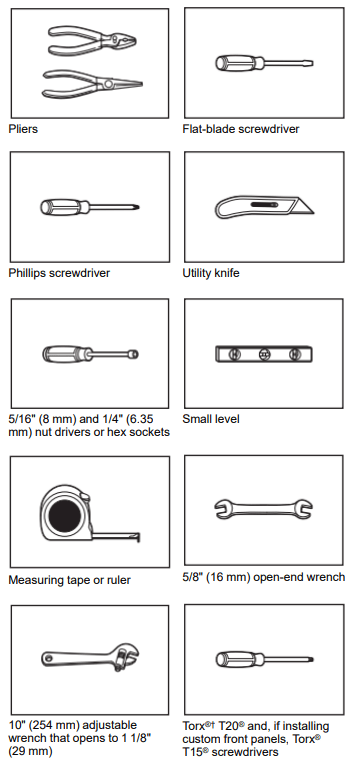
Other Useful Items You May Need:
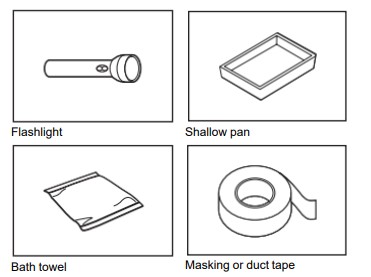
Parts Supplied
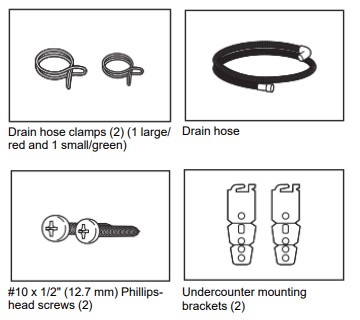
Make sure all these parts are included in the literature package.
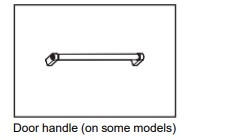
First-Time Installations
Check local codes. Check existing electrical supply. See the “Electrical Requirements” section. It is recommended that electrical connections be made by a licensed electrical installer.
Additional Tools Needed:
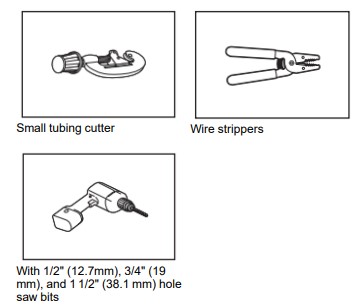
Additional Parts Needed (not provided):
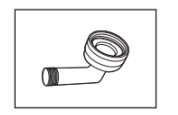
3/8" (9.5 mm) Compression x 3/4" (19 mm) Hose Fitting with rubber seal and 90° elbow (required to properly connect household water line to the dishwasher)

Household Wiring (Metallic) Strain Relief to fit 7/8" (22 mm) hole (required to properly secure household wiring to the dishwasher terminal box)
NOTE: Use only: Straight: Whirlpool Part Number 4317824, 90°: Whirlpool Part Number W10278923RP
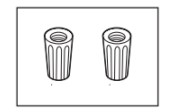
Twist-On Wire Connectors
NOTES:
- Confirm proper size for connecting your gauge of household wiring to the 16- gauge wiring in the dishwasher.
- Use only: Straight: Whirlpool Part Number 4317824, 90°: Whirlpool Part Number W10278923RP
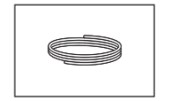
Copper Tubing (3/8" [9.5 mm] O.D. suggested) or Flexible Braided Water Supply Line Kit.
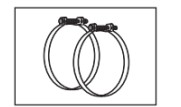
Screw-Type Clamps 1 1/2"– 2" (38 mm–50 mm) (3 maximum)
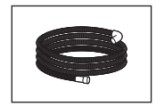
Optional – Longer Drain Hose Maximum length 12 ft. (3.7 m)
NOTE: Must meet AHAM/ IAPMO test standards, fit 1" (25 mm) drain connection, and be resistant to heat and detergent.
NOTE: Be sure to purchase only Whirlpool factory-certified parts and accessories for your appliance. Your installation may require additional parts. To order, refer to the contact information referenced in your Quick Start Guide.
NOTE: If using a flexible braided hose, replace inlet hose after 5 years to reduce the risk of hose failure. Record hose installation or replacement dates on the hose for future reference.
Location Requirements
Dishwasher must be fully enclosed (top, sides, back, and floor) upon installation. A side panel kit is available from your dealer for installing your dishwasher at the end of your cabinetry. An optional moisture barrier accessory is also available for installing underneath a wooden countertop. Check location where dishwasher will be installed. The location must provide:
- Convenient access for loading and unloading dishes. Corner locations require a 2" (51 mm) minimum clearance between the side of the dishwasher door and the wall or cabinet.
- Easy access to water, electricity, and drain:
• Grounded electrical supply is required.
• This dishwasher has a water-heating feature and also requires a connection to a hot water supply line.
• Make sure pipes, wires, and drain hose are within the shaded area shown in the “Cabinet Opening Dimensions” section.
• Do not run drain lines, water lines, or electrical wiring where they can interfere with or contact dishwasher motor or legs.
• Shelter dishwasher and water lines leading to dishwasher against freezing. Damage from freezing is not covered by the warranty.
NOTE: If dishwasher will be left unused for a period of time or in a location where it may be subject to freezing, have it winterized by authorized service personnel.
• If installed in new construction, flush the water supply line of debris before connecting it to the fill valve. If it is not flushed, debris from the water supply could plug the fill valve screen.
- A square opening for proper operation and appearance.
- The cabinet front to be perpendicular to floor.
- A level floor.
Helpful Hint: If floor at front of opening is not level with floor at rear of opening, shims may be used to level dishwasher.
NOTE: To avoid shifting during dishwasher operation, shims must be securely attached to the floor.
- The location where the dishwasher will be installed must provide clearance between motor and flooring. Motor should not touch the floor.
- Do not install dishwasher over carpeted flooring.
Cabinet Opening Dimensions
Clearances
Check that all surfaces have no protrusions that would prohibit dishwasher installation.
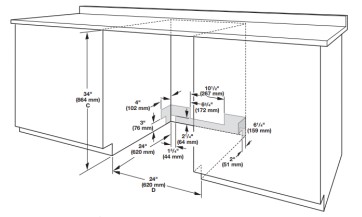
C. Measured from the lowest point on the underside of the countertop. May be reduced to 33 1/2" (851 mm) by removing the wheels and perforated area of insulation (blanket) on dishwasher.
D. Minimum, measured from narrowest point of opening.
NOTE: Shaded areas of cabinet walls show where utility connections may be installed.
Drain Requirements
- A new drain hose is supplied with your dishwasher. If drain hose is not long enough, use a new drain hose with a maximum length of 12 ft. (3.7 m) that meets all current AHAM/ IAPMO test standards, is resistant to heat and detergent, and fits the 1" (25 mm) drain connector of the dishwasher.
NOTE: Do not connect multiple drain hoses together.
- Make sure to connect drain hose to waste tee or disposer inlet above drain trap in house plumbing and 20" (508 mm) minimum above the floor. It is recommended that the drain hose either be looped up and securely fastened to the underside of the counter or be connected to an air gap.
- Make sure to use an air gap if the drain hose is connected to house plumbing lower than 20" (508 mm) above subfloor or floor.

- If required, the air gap should be installed in accordance with the air gap installation instructions. When you are connecting the air gap, a rubber hose (not provided) will be needed to connect to the waste tee or disposer inlet.
- Use 1/2" (12.7 mm) minimum I.D. drain line fittings.
Water Supply Requirements
- This dishwasher has a water heating feature and also requires a connection to a hot water supply line.
- A hot water line with 20 to 120 psi (138 to 862 kPa) water pressure can be verified by a licensed plumber.
- 120°F (49°C) water at dishwasher
- 3/8" (9.5 mm) O.D. copper tubing with compression fitting or flexible braided water supply line
NOTE: 1/2" (12.7 mm) minimum plastic tubing is not recommended.
- A 90° elbow with 3/4" (19 mm) hose connection with rubber washer
- Do not solder within 6" (152 mm) of the water inlet valve.
- If installed in new construction, make sure the house water supply lines have been flushed prior to connecting the dishwasher to remove any debris that may exist in the supply line.
NOTE: If replacing an existing dishwasher, it is recommended to install a new water line and drain hose (supplied) with the new dishwasher.
Electrical Requirements
Be sure that the electrical connection and wire size are adequate and in conformance with the National Electrical Code, ANSI/NFPA 70 – latest edition, and all local codes and ordinances.
For a fee, a copy of the above code standards can be obtained from: National Fire Protection Association 1 Batterymarch Park Quincy, MA 02169-7471
You Must Have:
- 120 V, 60 Hz, AC-only, 15 A or 20 A, fused electrical supply.
- Copper wire only.
- A maximum of 2 field wiring supply conductors (12 AWG largest size) plus 1 grounding conductor are permitted in the terminal box.
We Recommend:
- A time-delay fuse or circuit breaker.
- A separate circuit.
If Connecting Dishwasher with a Power Cord:
- Use a UL-listed power cord kit marked for use with dishwasher. See the “Tools and Parts” section for part details.

- Plug into a grounded 3-prong outlet. Outlet must meet all local codes and ordinances.

If Connecting Dishwasher with Direct Wiring:
- Use flexible, armored, or nonmetallic sheathed copper wire with grounding wire that meets the wiring requirements for your home and local codes and ordinances.

- Use a UL-listed/CSA-approved metallic strain relief.
INSTALLATION
You Need To:
- Slowly open dishwasher door while someone grasps the rear of the dishwasher. Remove shipping materials and drain hose. Close dishwasher door until latched.
NOTE: Each dishwasher is tested at the factory and may contain some residual water in the tub as a result of the test.
- Observe all governing codes and ordinances.
- Install this dishwasher as specified in these instructions.
- Installation should be performed by a qualified service technician.
- The dishwasher must be installed to meet all electrical and plumbing national and local codes and ordinances.
- Care shall be exercised when the appliance is installed or removed to reduce the likelihood of damage to the power cord.
WARNING: To reduce the risk of electric shock, fire, or injury to persons, the installer must ensure that the dishwasher is completely enclosed at the time of installation.
Before You Begin
1. Disconnect power
Disconnect electrical power at the fuse box or circuit breaker box before installing dishwasher.
2. Shut off water supply
Shut off water supply to the dishwasher.
Prepare Cabinet Opening – New Utilities
3. Drill hole locations – new construction

- The power-supply receptacle for the appliance shall be installed in a cabinet or on a wall adjacent to the undercounter space in which the appliance is to be installed.
NOTE: Refer to the “Cabinet Opening Dimensions” section for the correct hole placement and dimensions of the shaded area
- Drill a 1 1/2" (38 mm) drain hole in the side or rear of cabinet, depending on the location of the drain hose routing and drain hose connection location.
- Drill a 1/2" (12.7 mm) water supply hose hole in the side or rear of cabinet, depending on location of water supply routing and connection location.
- Drill a 1 1/2" (38 mm) electrical conduit hole in the right-hand side or rear of the cabinet.
4. Sand holes smooth
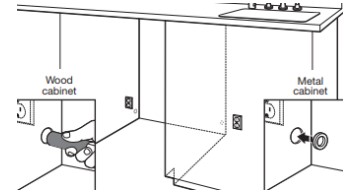
- Wood cabinet: Sand the hole until smooth.
- Metal cabinet: Cover edges of hole with grommet included with power cord kit. See the “Tools and Parts” section for part details.
Helpful Tip: Wiring the dishwasher will be easier if you route the cable into the cabinet opening from the right-hand side.
Install Optional Moisture Barrier (Recommended for Wood Countertops)
Moisture barrier/Wood shims

- Make sure the area under the cabinet is clean and dry for installation of the moisture barrier. Remove the backing of the moisture barrier and apply to underside of the countertop along the front edge of the counter.
NOTE: Install wood shims if side anchoring and the gap between sides of the dishwasher are greater than 1/2" (12.7 mm) on each side or are greater than the length of the anchor screws.
5. Built-up floors – add shims as needed
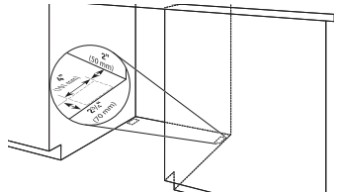
- Built-up floors: If the kitchen floor is higher than the cabinet opening’s floor—for example, the kitchen floor tile does not extend into the cabinet opening—add shims, as needed, in the area shown to bring the dishwasher up to 34" (864 mm) below the countertop.
NOTE: Shims must be securely attached to floor to avoid movement when the dishwasher is in use.
6. If installing into a 33 1/2" (851 mm) opening
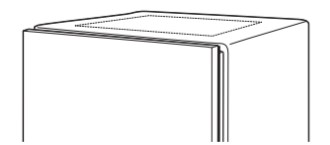
Cut insulation blanket along perforation for cabinet opening height of 33 1/2" (851 mm). For other cabinet opening heights, do not cut the insulation blanket.
Electrical Connection
– For Direct Wire, begin with step 7
– For Power Cord, wait until step 22
7. Direct wire – route cable
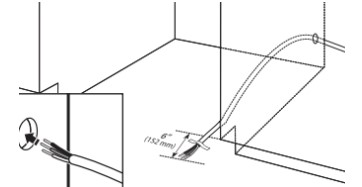
- If installing with direct wire, route the cable as shown.
- Route cable from power supply through cabinet hole. (Cable must extend to the right-front side of cabinet opening.) Tape cable to the floor in area shown. This will prohibit cable from moving when dishwasher is moved into cabinet opening.
NOTE: If removing a previous dishwasher with a power cord, you will need to transfer the power cord to the new dishwasher.
Prepare Dishwasher
8. Put dishwasher on its back
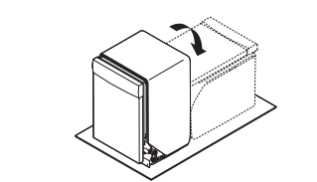
Helpful Tip: Place cardboard under dishwasher until installed in cabinet opening to avoid damaging floor covering.
- Using 2 or more people, grasp sides of dishwasher door frame and place the dishwasher on its back.
- Do not use the door panel as a worktable without first covering it with a towel to avoid scratching the door panel.
NOTE: On some models, once the dishwasher is on its back, pull on the door handle to remove it from the access panel.
Remove Access Panel
– For Plastic Access Panels, go to step 9
– For Metal Access Panels, go to step 10
9. Plastic panel

Using a flat-blade screwdriver, turn the plastic fasteners 1/4 turn counterclockwise to unlock them. Go to step 12.
10. Metal panel
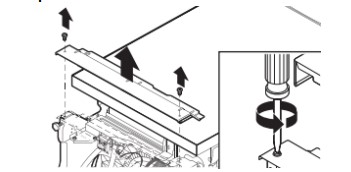
Using a 1/4" (6.35 mm) nut driver or Phillips screwdriver, remove 2 screws attaching access panel to dishwasher.
11. Measure cabinet opening
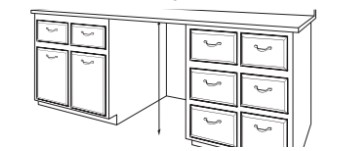
Measure height of cabinet opening from underside of countertop to floor where dishwasher will be installed. Be sure to measure the lowest point on the underside of the countertop and the highest point on the floor.

Front legs – A
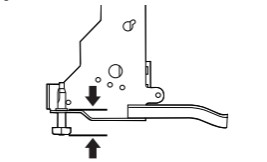
Rear legs – B

Adjust both front and back leveling legs to the same height.
NOTE: If the minimum cabinet opening height is less than 33 7/8" (860 mm), the rear leveling legs and spacers can be removed for additional clearance. This will allow the dishwasher to fit into a 33 1/2" (851 mm) high cabinet opening, but the dishwasher will be more difficult to move. (Measurements are approximate. Rear and front leveling legs are preset at the factory for 34 1/2" [876 mm].)
12. Adjust leveling legs
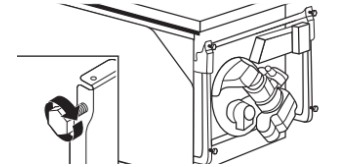
Refer to the “Dishwasher Height Adjustment Chart” for height of leveling legs needed for your cabinet opening.
13. Remove plastic rail cover
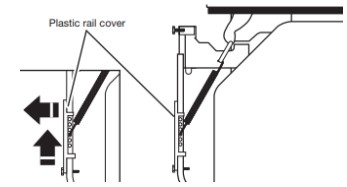
Remove and discard the plastic rail cover on each side of the dishwasher frame. To remove the plastic rail cover, push upward and back to unsnap it from the dishwasher frame.
Connect Water Line to Fill Valve
– For Copper Line, begin with step 14
– For Flexible Line, begin with step 16
14. Copper water line
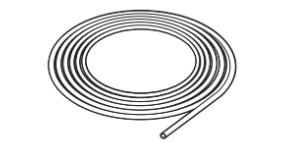
If using copper tubing, measure overall length of copper tubing required to reach the water supply, cut to length, and attach with compression fittings.
15. Slide nut and ferrule onto tubing (copper tubing only)

- Copper tubing only: Put the tubing into the 90° elbow fitting as far as it will go. (The copper tubing bends and kinks easily.) Slide the nut and ferrule forward and start the nut onto the elbow threads.
NOTE: To avoid vibration during operation, route the water supply line so that it does not touch the dishwasher base, frame, or motor. Go to step 18.
16. Flexible line

Flexible braided line: Confirm the flexible braided line is long enough.
17. Add 90° elbow fitting to the water supply line
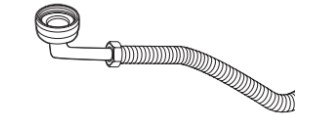
Get 3/8" (9.5 mm) compression x 3/4" (19 mm) hose fitting with 90° elbow. See the “Tools and Parts” section at the front of the guide for part details and order. Connect the 3/8" (9.5 mm) compression fitting of the 90° elbow fitting to the water supply line. Attach so the 3/4" (19 mm) connection is facing upward as shown above.
Connect Fill Hose to Fill Valve
18. Tighten 90° elbow fitting to valve
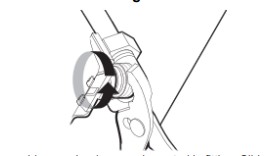
Be sure rubber washer is properly seated in fitting. Slide the 3/4" (19 mm) fitting of the 90° elbow up to the valve and hand-tighten to avoid cross-threading. Hand-tighten until the coupling is tight. Using pliers, check the tightness of the coupling. An additional 1/4 to 1/2 turn may be required to seal the rubber gasket. Route fill hose out the rear left side of unit.
NOTES:
- Do not use PTFE plumber's tape with compression fittings.
- Do not overtighten. Damage to the coupling can result.
Drain Hose Connection
19. Connect drain hose
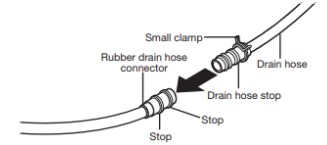
Place towel under drain hose to catch any water in drain hose. Place the small (green) drain hose clamp onto the small end of the drain hose. Push the new drain hose into the rubber drain hose connector up to the drain hose stop.
20. Slide clamp onto connector
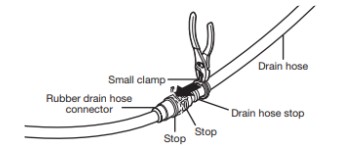
Using pliers, squeeze open the small drain hose clamp, and slide it onto the connector between stops.
21. Hose clamp final position

NOTE: Route drain hose out the rear of the dishwasher.
Power Cord Connection
NOTE: If removing a previous dishwasher with a power cord, you will need to transfer the power cord to the new dishwasher.
22. Remove terminal box cover
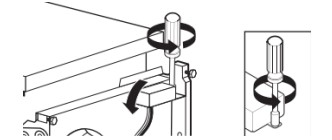
Using a 1/4" hex-head socket, nut driver, or Torx® T20® screwdriver, remove terminal box cover. Retain for later use.
23. Install strain relief
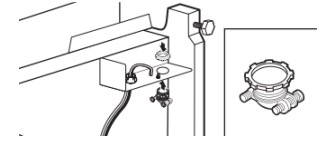
Install the metallic strain relief provided in this kit (Straight: Whirlpool Part Number 4317824, 90°: Whirlpool Part Number W10278923RP). Make sure screw heads are facing to the left when tightening conduit nut. Strain relief is provided with the power cord kit.
24. Power cord – route cord into terminal box
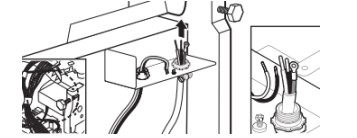
- Route cord so that it does not touch dishwasher motor or lower part of dishwasher tub. Pull cord through strain relief in terminal box.
NOTE: A maximum of 2 power cord supply conductors (12 AWG largest size) plus 1 grounding conductor are permitted in the terminal box.
25. Power cord – connect ground wire
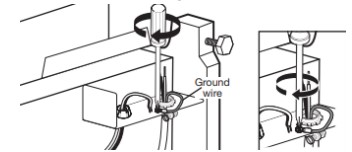
Remove the ground connector screw and place it through the ring terminal of the green ground wire of power cord. Reattach and tighten the ground connector screw.
26. Power cord – connect remaining wires
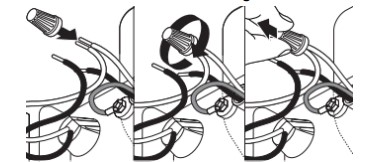
- Select twist-on wire connectors of the proper size provided in this kit (Straight: Whirlpool Part Number 4317824, 90°: Whirlpool Part Number W10278923RP) . Connect wires, black to black and white to white, using the twist-on wire connectors.
NOTE: Do not pre-twist stranded wire. Twist on wire connector. Gently tug on wires to be sure both are secured.
27. Power cord – secure cord in strain relief

Tighten strain relief screws to secure cord.
28. Power cord – reinstall terminal box cover and wires
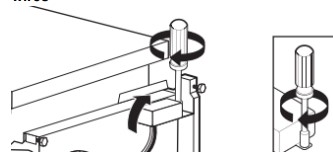
- Place wires inside terminal box. Insert tabs on left side of cover. Make sure wires are tucked inside the box and not pinched by the cover. Use a 1/4" hex-head socket, nut driver, or Torx® T20® screwdriver, and the screw removed in step 22 to secure the terminal box cover.
- If power cord supplied model, remove the first tie strap closest to the plug to maximize the cord length. Do not remove any other tie straps.
NOTE: Route power cord out the rear of the dishwasher. Do not plug cord into an outlet until instructed to do so.
Install Door Handle (on some models)
29. Install door handle
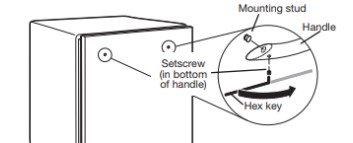
IMPORTANT: Do not scratch the front panel during this procedure. If door panel has a protective film, peel film back past the point of the handle studs before installing handle. Handle is easiest to install while unit is on its back.
- Remove the door handle and hex key from the packaging. Setscrews are already installed in the handle. Place handle on mounting studs with the setscrews facing down. Push the door handle tightly against the door. Insert the short end of the hex key into the setscrews. Tighten the setscrews 1/4 turn past snug.
- Retain hex key with Owner’s Manual.
Place Dishwasher in Cabinet
30. Stand dishwasher upright
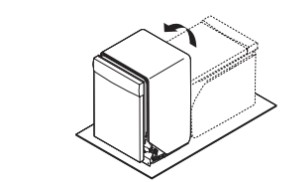
- Using 2 or more people, stand the dishwasher up.
NOTE: Do not install kick plate until instructed to do so.
IMPORTANT: If wheels were removed, cover the floor when moving the dishwasher. Slowly move dishwasher completely into cabinet opening. Do not kink or pinch water line, drain hose, power cord, or direct wire between dishwasher and cabinet. Remove cardboard from under dishwasher.
- It is all right if dishwasher fits tightly into cabinet opening. Do not remove insulation blanket—the blanket reduces the sound level.
NOTE: Route water supply, drain hose, and power cord out the rear of the dishwasher.
31. Move dishwasher close to cabinet opening
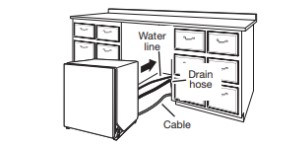
Route the utilities through the holes in the cabinet and pull the slack out at the same time as the dishwasher is pushed into the cabinet.
32. Route power cord.
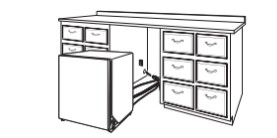
If using a power cord, make sure to route end through hole in cutout before sliding dishwasher into cabinet opening.
33. Secure installation blanket

NOTE: Make sure insulation blanket is secured at both left and right rear corners before pushing into cabinet opening to keep the blanket from bunching up in a tight-fitting cabinet.
34. Move dishwasher all but 6" (152 mm) into cabinet opening

NOTE: Leave unit about 6" (152 mm) out from cabinet in order to install anchor brackets and adjust door tension if needed.
35. Pull slack from utilities
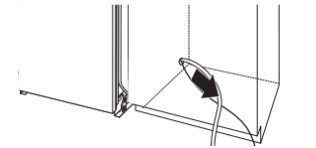
NOTE: Pull slack out of utilities at the same time the dishwasher is pushed into the cabinet opening to avoid any kinks.
Check Operation
- Read the dishwasher Quick Start Guide that came with your dishwasher.
- Check that all parts have been installed and no steps were skipped. Check that you have all tools used.
If the dishwasher is not working properly, disconnect power or unplug dishwasher and refer to the “If Dishwasher Does Not Operate” section.
If Dishwasher Does Not Operate
First try the solutions suggested here to possibly avoid the cost of a service call.
- Has the circuit breaker tripped or the house fuse blown?
- Is the door closed tightly and latched?
- Has the cycle been set correctly to start the dishwasher?
- Is the water turned on?
If none of these possible solutions work, refer to the contact information referenced in your Quick Start Guide.
Additional Tips
- Expect longer wash times. Your new dishwasher will average 2–5 hours per load but use nearly 40% less energy than older models. Designed with a low-wattage, low-energy-consumption motor, your dishwasher washes longer to ensure exceptional cleaning. Certain models are equipped with an optical water sensor, so the first cycle will run longer to calibrate the optical sensor. Selecting certain options could increase cycle time past 3.5 hours.
- Rinse aid is necessary for good drying results: This dishwasher is designed to be used with rinse aid for good drying performance and controlling hard-water-deposit buildup. Energy-efficient dishwashers use less water and energy, so they depend on the water sheeting action of rinse aid for good drying performance.
- Start/Resume light may flash: When pressing Start/Resume, you must make sure the door is closed within 3 seconds. If you do not close the door within 3 seconds, the Start/Resume light will flash until you press it again. (You must also do this when adding a dish during the middle of a cycle.)
DISHWASHER MAINTENANCE AND CARE
User-Maintenance Instructions
Cleaning the Exterior
- Clean the exterior of the dishwasher with only a soft, damp cloth and mild detergent. If your dishwasher has a stainless steel exterior, it may have a coating that is resistant to fingerprints. Avoid using abrasive cleaning products on the exterior of the dishwasher.
Cleaning and Maintaining the Interior
- Many detergents may leave white spots or a white residue on dishware and on the interior of the dishwasher. Over time this residue can become unsightly and could affect dishwasher performance. Use of a dishwasher cleaning product such as affresh®† Dishwasher Cleaner can help to remove the residue. Monthly use of affresh®† Dishwasher Cleaner is recommended to help maintain the dishwasher. Follow package directions.
- Another method to remove white residue is to use a vinegar rinse. However, vinegar is an acid and using it too often could damage your dishwasher.
- Place (do not pour) 2 cups (500 mL) white vinegar in a glass or dishwasher-safe measuring cup on the bottom rack. Run the dishwasher through a complete washing cycle using an air-dry or an energy-saving dry option. Do not use detergent. Vinegar will mix with the wash water.
NOTE: We recommend the use of high-quality, premeasured detergent tablets or packs and the use of rinse aid for dishwasher cleaning and daily care.
- If you have a drain air gap, check and clean it if the dishwasher is not draining well.
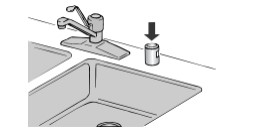
To Reduce Risk of Property Damage During Vacation or Extended Time Without Use
- When you will not be using the dishwasher during the summer months, turn off the water and power supply to the dishwasher.
- Make sure the water supply lines are protected against freezing conditions. Ice formations in the supply lines can increase water pressure and cause damage to your dishwasher or home. Damage from freezing is not covered by the warranty.
- When storing your dishwasher in the winter, avoid water damage by having your dishwasher winterized by authorized service personnel.
Cleaning the Filters
It is very easy to remove and maintain the filters. The chart below shows the recommended cleaning frequency.
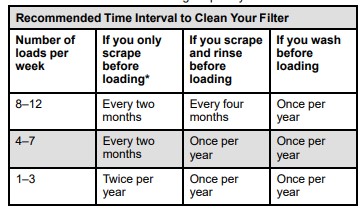
*Manufacturer's recommendation: This practice will conserve the water and energy that you would have used to prepare your dishes. This will also save you time and effort.
Very Hard Water
- If you have hard water (above 15 grains), clean your filter at least once per month. Building up of white residue on your dishwasher indicates hard water. For tips on removing spots and stains, see the online “Troubleshooting” section.
NOTE: Online references can be found in the Quick Start Guide.
Filter Removal Instructions
- Turn the upper filter assembly 1/4 turn counterclockwise and lift out.
- Separate the upper filter assembly by gently pulling apart.
- Clean the filters as shown.

Cleaning Instructions
IMPORTANT: Do not use wire brush, scouring pad, etc., as they may damage the filters.
- Rinse filter under running water until most soils are removed. If you have hard-to-remove soils or calcium deposits from hard water, a soft brush may be required.

See other models: WDTA50SAKN KDTE204KPS KDFE204KPS WEGA25H0HZ MFI2570FEZ08
